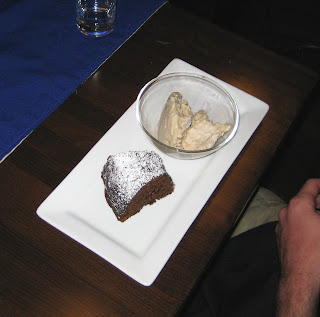Dry ice ice cream: looks like a typo, but it's not!
A few weeks ago I got obsessed with the idea of making ice cream using liquid nitrogen. A couple of places around town are doing it, and the theory is that the faster you freeze the ice cream base, the less time the ice crystals have to form, so you get very small ice crystals and hence a super-smooth ice cream. Jill and I checked out the process at The Crushery on South Pearl, and it's true, their ice cream was extremely smooth (and extremely cold--you could pick up flakes of it and it wouldn't melt). However, when I did some research on how to acquire liquid nitrogen, I found several stories of terrible liquid nitrogen accidents, including some in kitchens (since it's stored in pressurized tanks, if something goes wrong the tank can easily fly through your wall). So then I thought about using dry ice, which is not nearly as cold, and doesn't have to be stored under pressure.
Dry ice, which is solid carbon dioxide, is pretty easy to buy, and does chill liquids very quickly (and with a satisfying cloud of "smoke"). However, it also carbonates the liquid, which we discovered when I made my first batch of dry ice ice cream using coffee ice cream base. Carbonated coffee is not good. So then we brainstormed some ice cream flavors that carbonation would actually enhance, and we came up with a good list: champagne, root beer, real beer. We have a milk stout on our beer list, so we decided to work with that, and after a few experiments, we figured out how to make milk stout ice cream right at your table:
 |
| First we combine the dairy and the beer in a bowl. |
 |
| Then we add the dry ice and stir for about one minute. |
 |
| The finished ice cream is served with a ginger spice cake (also made with stout)! |
Our servers, who actually have to do all the work here, have been good sports about this crazy dish, and it certainly is impressive to watch!






